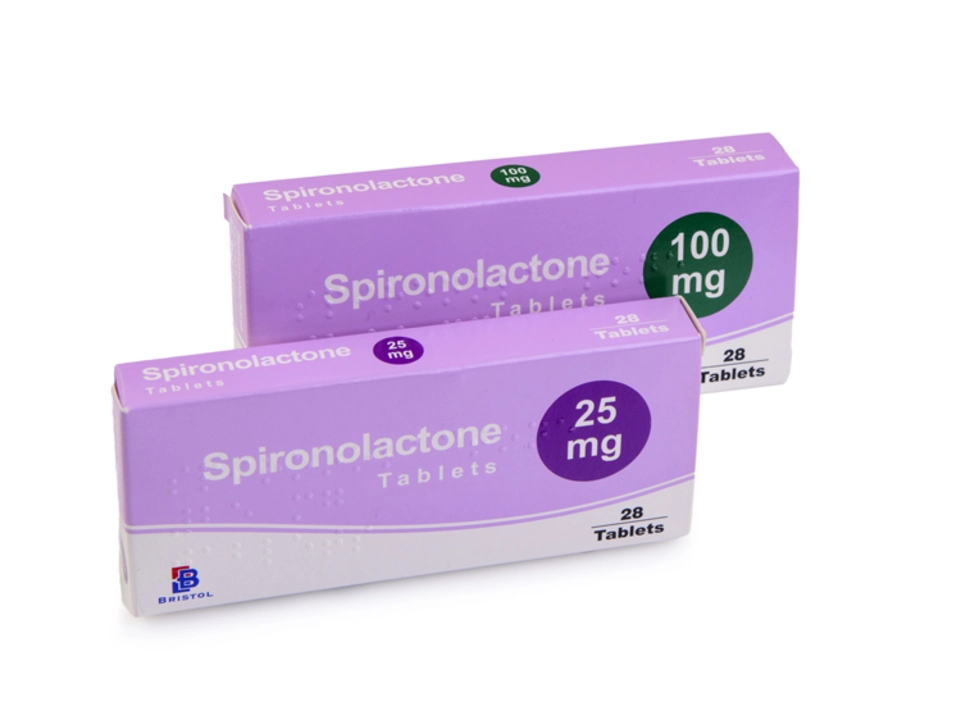Managing Spironolactone-Induced Hyperkalemia

Understanding Spironolactone and Its Effects on Potassium Levels
As a diuretic medication, Spironolactone is commonly used to treat conditions such as high blood pressure, heart failure, and fluid retention. While it can be an effective treatment option, it also has the potential to cause an increase in potassium levels, known as hyperkalemia. In this section, we will explore what Spironolactone is, how it works, and why it can lead to elevated potassium levels.
Spironolactone is a potassium-sparing diuretic, meaning it helps the body get rid of excess fluid without causing a significant loss of potassium. It works by blocking the action of a hormone called aldosterone, which is responsible for regulating the balance of sodium and potassium in the body. By doing this, Spironolactone allows the kidneys to remove more sodium and water from the body, while retaining potassium. However, in some cases, this potassium retention can lead to hyperkalemia.
Recognizing the Symptoms of Hyperkalemia
It is important for individuals taking Spironolactone to be aware of the signs and symptoms of hyperkalemia, as early detection can help prevent serious complications. Some common symptoms of high potassium levels include:
- Weakness or fatigue
- Nausea
- Irregular heartbeat
- Shortness of breath
- Chest pain
- Numbness or tingling in the extremities
If you experience any of these symptoms while taking Spironolactone, it is important to contact your healthcare provider right away. They may need to adjust your medication or recommend additional tests to determine the underlying cause of your symptoms.
Monitoring Your Potassium Levels
One of the most effective ways to manage Spironolactone-induced hyperkalemia is by regularly monitoring your potassium levels. This can be done through routine blood tests ordered by your healthcare provider. By keeping a close eye on your potassium levels, your healthcare team can make any necessary adjustments to your medication or treatment plan to ensure your potassium remains within a safe range.
In addition to blood tests, it's also a good idea to familiarize yourself with the normal range for potassium levels. For most people, this is between 3.5 and 5.0 milliequivalents per liter (mEq/L). If your potassium levels consistently fall outside of this range, it may be necessary to make changes to your medication or lifestyle in order to prevent complications.
Dietary Changes to Manage Hyperkalemia
Another key aspect of managing Spironolactone-induced hyperkalemia is making dietary changes to help keep your potassium levels in check. This may involve limiting high-potassium foods, such as:
- Bananas
- Avocados
- Spinach
- Tomatoes
- Oranges and orange juice
- Potatoes
- Dried fruits
Instead, focus on consuming low-potassium foods, such as:
- Apples and apple juice
- Blueberries
- Green beans
- Cabbage
- Cranberries and cranberry juice
- Pineapple
- Rice
It's also important to discuss any dietary changes with your healthcare provider, as they can provide guidance on the best diet plan to help manage your potassium levels.
Working with Your Healthcare Team to Manage Hyperkalemia
When it comes to managing Spironolactone-induced hyperkalemia, collaboration with your healthcare team is crucial. They can help you monitor your potassium levels, adjust your medication as needed, and provide guidance on dietary changes to keep your potassium levels within a safe range. It's important to maintain open communication with your healthcare provider and to follow their recommendations closely.
By being proactive in managing your potassium levels and working closely with your healthcare team, you can minimize the risk of Spironolactone-induced hyperkalemia and maintain your overall health and well-being.






Comments
Holly Green
May 15, 2023 AT 08:25Keeping an eye on your potassium levels is the simplest way to avoid trouble while on Spironolactone. A routine blood test every few months can spot any rise before it becomes dangerous.
Craig E
May 23, 2023 AT 07:33The physiological dance between aldosterone blockade and potassium retention is fascinating, yet it demands vigilance. By understanding the underlying mechanisms, patients can better cooperate with their clinicians, and perhaps even adjust their dietary choices with confidence.
Marrisa Moccasin
May 31, 2023 AT 06:40So, you think you can just pop a diuretic and ignore the potassium surge, right?, but the body has its own checks, and when aldosterone is blocked, sodium goes out and potassium sticks around, which can lead to the classic symptoms-weakness, nausea, palpitations-so don’t be complacent, get your labs done, and talk to your doctor, ASAP.
Caleb Clark
June 8, 2023 AT 05:46Alright, folks, let me break it down step by step, because managing spironolactone‑induced hyperkalemia is not rocket science but it does need a game plan, first you schedule a baseline potassium test before you even start the med, then you repeat it after a week or two to see the trend, if the number creeps above 5.0 mEq/L you have to act, cut back on high‑potassium foods like bananas and avocados, and swap for low‑potassium alternatives like apples and rice, don’t forget to stay hydrated because dehydration can concentrate potassium even more, also keep an eye on any muscle weakness or weird heartbeats, those are red flags, talk to your physician about possibly lowering the dose or adding a potassium‑binding resin, some patients even benefit from a low‑sodium diet to help the kidneys excrete excess potassium, remember that lab results can vary a bit, so look at the pattern not a single reading, and finally keep a log of your diet and symptoms, it helps the doctor see what’s going on, if you follow these steps you’ll minimize the risk and stay on track with the benefits of spironolactone, good luck! Additionally, over‑the‑counter supplements like potassium chloride can tip the balance, so avoid them unless prescribed, and be wary of hidden potassium in salt substitutes used in cooking. Finally, if you ever feel chest pain or severe shortness of breath, treat it as an emergency and seek care immediately.
Eileen Peck
June 16, 2023 AT 04:53Monitoring is key, but don’t let the doctor visits become a nightmare-just bring a list of what you eat, and ask if any of those foods are too high in potassium. If you’re unsure, a quick call to the clinic can save you from a bad surprise.
Oliver Johnson
June 24, 2023 AT 04:00Honestly, the government shouldn’t be telling you what to eat.
Taylor Haven
July 2, 2023 AT 03:06When you consider that spironolactone is doing a double‑duty-acting as a diuretic while also sparing potassium-you have to respect the balance it tries to maintain, yet the balance can tip over if you’re not careful, which is why I always recommend a weekly weigh‑in and a quick finger‑stick test if you have a home monitor, also keep a spreadsheet of your potassium readings, track any new fatigue or tingling, and cross‑reference it with your diet, because even foods you think are harmless, like certain beans or nuts, can push the level up, and if you notice a steady rise, call your prescriber before the next scheduled appointment, they might adjust the dose or suggest a potassium binder, remember that the goal is to keep the heart happy while managing fluid, not to cause a cascade of cardiac arrhythmias, so stay proactive, stay educated, and stay in touch with your health team.
Sireesh Kumar
July 10, 2023 AT 02:13I’ve read dozens of papers on aldosterone blockade, and the consensus is that patient education beats blind prescription every time; a casual chat over tea about the role of potassium can make a huge difference.
Jonathan Harmeling
July 18, 2023 AT 01:20It’s simple: if your potassium shoots up, cut the salty snacks, drink more water, and let your doctor know ASAP.
Ritik Chaurasia
July 26, 2023 AT 00:26Stop whining about potassium – the real problem is people who don’t read the label and think they’re invincible.
Gary Marks
August 2, 2023 AT 23:33Let me tell you, hyperkalemia is not a myth whispered by conspiracy theorists, it’s a real, silent killer that creeps in when you ignore the obvious signs, you think you’re fine because you feel okay today, but the heart doesn’t lie, and those little tingles in your fingers are the body screaming for help, so stop scrolling memes and actually get a blood test, replace those banana smoothies with berry packs, ditch the processed cheese, and if your doctor shrugs, find one who actually cares, because your life is worth more than a cheap prescription.
Vandermolen Willis
August 10, 2023 AT 22:40Thanks for the tip! 👍 I’ll definitely bring a food list next time.
Mary Keenan
August 18, 2023 AT 21:46Cut the crap and just get the labs done, no excuses.
Steven Young
August 26, 2023 AT 20:53the potassium level change is a sign you ignore it at your own risk
Kelly Brammer
September 3, 2023 AT 20:00Accurate monitoring of serum potassium is essential for safe spironolactone therapy.
Ben Collins
September 11, 2023 AT 19:06Oh sure, because everyone loves staring at numbers all day.
Denver Bright
September 19, 2023 AT 18:13Just remember, the kidneys are your best friend when it comes to potassium balance.
Kelli Benedik
September 27, 2023 AT 17:20Whoa, this is like a thriller plot! 🚨💥 My potassium could be the villain!
cariletta jones
October 5, 2023 AT 16:26Stay positive, stay monitored, stay healthy.
Kevin Hylant
October 13, 2023 AT 15:33What’s the best weekly schedule for checking potassium levels?